|
If you want to know what was
really going on at some point in the past, there is usually nothing more reliable
than reading a print story or advertisement from the era. That way you're
getting the news "straight from the horse's mouth," so to speak, rather than
being interpreted or filtered by some unassociated source. This report on "The
Transistor in Industry" was written in 1956 by Mr. Frank Durat, a product
manager at Raytheon, at a time when transistors were first making inroads for
replacing the venerable vacuum tube (valve) which had launched and propelled the
electronics industry since 1908 when Lee de Forest introduced the triode
Audion
amplifier. Germanium and silicon were the semiconductor base crystals du jour,
and achieving the requisite purity was a primary concern for advancing the state
of the art for higher frequencies, power handling, and circuit density (for
integrated circuits).
The Transistor in Industry
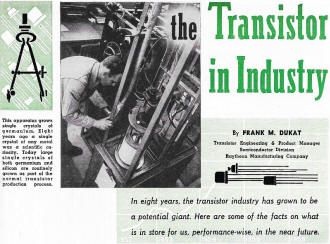 By Frank M. Dukat By Frank M. Dukat
Transistor Engineering & Product Manager Semiconductor Division
Raytheon Manufacturing Company
In eight years, the transistor industry has grown to be a potential giant. Here
are some of the facts on what is in store for us, performance-wise, in the near
future.
This apparatus grows single crystals of germanium. Eight years ago a single crystal
of any metal was a scientific curiosity. Today large single crystals of both germanium
and silicon are routinely grown as part of the normal transistor production process.
It is now nearly eight years since Bardeen and Brattain of Bell Telephone Laboratories
announced the invention of semiconductor amplifiers or transistors. The progress
to date is remarkable and is a fitting tribute to the thousands of engineers and
scientists in over sixty companies who have been instrumental in the development
and production refinement of semiconductor devices. At times progress has seemed
slow, but one must remember that invention is only the first step along the hard
road to an engineering performance level which is consistent with price; but when
this final step has been achieved, then transistors become commercial realities
and their acceptance, as such, is indicated by an increased rate of use. Industry
figures now clearly show this.
For 1953 information is unavailable, but total sales were probably somewhat less
than one million units. Industry figures show over a million units sold in 1954.
In 1955 sales were over three million units and in 1956, with the advent of new
portable and hybrid auto sets, total sales could double. See Table 1 on page 41
for report on sales. Still this is only a small percentage of the total tube market
which has averaged about 250 million units for new entertainment equipment alone
over the last five years. It is, therefore, appropriate at this time to review the
present status of the transistor to see what problems remain and what solutions
are at hand.
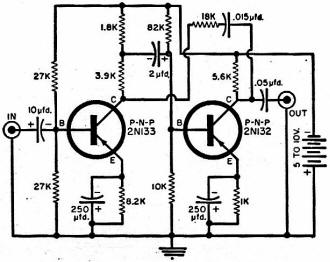
Fig. 1. A transistor phono preamplifier which exceeds tube performance
from the hiss standpoint as well as eliminating all hum and microphonic difficulties.
The frequency response is compensated for use with a reluctance type pickup.
The field of application for transistors is very large indeed since, in addition
to their use in conventional and well known circuitry now using tubes, they possess
certain inherent characteristics which open up applications in areas where the tube
has been unable to compete with more efficient mechanical devices. In the former
category are, of course, communication equipment, computers, servo systems, and
the like. In the latter are many relay and switching applications; for example,
the use of transistors makes a completely automatic telephone switchboard feasible
with mechanical switching replaced by electronic methods.
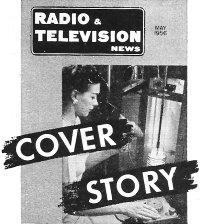 The operator is growing a crystal of silicon
from a crucible containing molten silicon at a temperature of 2650° F. A solid
seed of silicon is placed into the molten pool and the temperature distribution
so arranged by control of the induction heater that freezing begins to take place
onto this seed. The seed is then pulled from the melt, taking with it solid silicon.
The temperature is so controlled that the seed widens into a crystal over one inch
in diameter during growth. Such a crystal can potentially produce over 2000 transistors. The operator is growing a crystal of silicon
from a crucible containing molten silicon at a temperature of 2650° F. A solid
seed of silicon is placed into the molten pool and the temperature distribution
so arranged by control of the induction heater that freezing begins to take place
onto this seed. The seed is then pulled from the melt, taking with it solid silicon.
The temperature is so controlled that the seed widens into a crystal over one inch
in diameter during growth. Such a crystal can potentially produce over 2000 transistors.
By virtue of going through this procedure, the solid is made in single crystal
form with an orientation which is that of the seed. For silicon or any material
merely randomly frozen out of a melt, hundreds of crystals of random orientation
would result in the rod. This machine makes it possible to confine the solid material
to only one crystal. Single crystal material is necessary for either semiconductor
diodes or transistors.
A feature of this furnace, which is particularly interesting, is that it is designed
for the growing of silicon where in previous years such furnaces were used only
for germanium crystal growth. With the coming of high temperature devices such as
silicon rectifiers and silicon transistors it has been necessary to evolve this
type of furnace design to cope with the extremely high melting point and chemical
activity of silicon. For example, a tendency for silicon to dissolve its own crucibles
has been solved here.
The specific function being performed by the operator in the cover photo is to
check on the temperature of the liquid pool of silicon with an optical pyrometer.
The optical pyrometer shown works on the principle of comparing the color of a glowing
hot filament with the color of the object being observed. The dial reading is a
measure of the amount of current needed to heat the filament and is calibrated in
degrees of temperature.
It is beyond the scope of this article to consider more than a small portion
of the field. Therefore, we will concentrate primarily upon communication devices
used for entertainment. In so doing, many other applications are covered, for entertainment
equipment today covers about as wide a frequency and power range as most applications
in other more specialized fields.
Very early in transistor history it was recognized that the advantages of the
transistor lay in its small size, low power requirements, mechanical strength, and
freedom from microphonics. Potentially, it had better reliability and lower cost
than a tube. At the same time high noise, poor high-frequency performance, and restricted
temperature ranges were then considered limitations. However, since that time continued
transistor development has removed many of these initial restrictions.
In the case of noise there are many readily available audio transistors today
that have a better output signal-to-noise ratio in typical preamplifier circuits
than a tube doing the same job. This advantage is over and above the elimination
of microphonic and hum problems. As an example, consider the performance of a 2N133/2N132
preamplifier (Fig. 1) for use with a reluctance pickup as compared to a typical
6SC7. The transistor has an output signal-to-noise ratio 6 db better than the tube.
But the transistor is not always quieter than a tube. In the audio circuit described
the tube is at a disadvantage because it is operating as a voltage amplifier with
a poor transconductance/plate current ratio. At radio frequencies transistor noise
has not been too thoroughly investigated but is close enough to a tube in the broadcast
'band 'so that transistorized portable receivers of good sensitivity are comparable
to tube sets.
Temperature
All semiconductors by their very nature have temperature limitations. Actually
there are two maximum and minimum junction temperatures to consider. One pair is
the maximum and minimum junction temperature that causes destructive or irreversible
effects to occur, while the other pair represents the extremes of the range over
which the application may be expected to operate satisfactorily. The high temperature
end of the former is generally a point somewhat below the melting point of the solder
used to make connection to the transistor elements. The term "somewhat below" is
used because transistors, like tubes, must be baked out during processing at temperatures
in excess of any which they may encounter in service. In well designed germanium
transistors the maximum rated temperature, often called storage temperature, is
at least 185° F. On the other hand, there are few circuits that can be made to operate
satisfactorily at junction temperatures of 185° F because the change in characteristics
of the transistor from low temperatures to 185° F cannot be adequately compensated.
Hence, the application sets an upper limit on temperature range more than the transistor
itself. For an average application of germanium (other than power transistors) 150°
F is a reasonable figure. At the low temperature end few destructive effects are
apparent unless the enclosure opens up as the result of mechanical stresses. But,
from the application standpoint, low temperatures limit performance, al-though little
trouble in this regard should be encountered in the usual "entertainment" circuitry.
In military applications performance over a wide range of temperatures is mandatory
and it is here that silicon transistors play their most important role, particularly
at the high temperatures, for their low-temperature performance is worse than that
of germanium. Presently available silicon transistors can be operated with junction
temperatures of 350° F with no destructive effects, but, again, as a practical
matter, the average application limits their maximum junction temperature to about
275° F. It is unlikely that they will be used extensively in the entertainment
market for two reasons. First, germanium transistors seem to have the advantage
over silicon in all respects except the ability to operate at high temperatures.
Second, unless someone finds a way to purify silicon cheaply, the inherent cost
of silicon transistors will always be more than germanium.
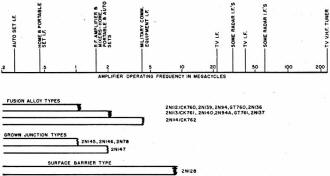
Fig. 2 - Operating range of commercially-available transistors
to an approximate twenty per-cent (20%) alpha cut-off frequency criterion. It should
be realized here that the extreme ends of the operating range are not by any means
exact.
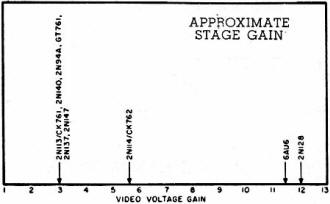
Fig. 3 - Comparison of transistors and tubes in a 3.5 video amplifier.
It is ironic that silicon, one of the most common elements, is so difficult to
purify to the degree needed for transistors that it cannot compete with germanium
which, although about as costly as gold, is extremely easy to purify. Actually,
the value of purified silicon and purified germanium is about the same; the basic
problem is that of recovery of waste material during transistor manufacture. Waste
germanium can be so successfully recovered at low cost that not much more than that
necessarily contained in the finished transistor is lost. In the case of silicon,
the cost of recovery is so high that it is just as well to start with new raw material.
Frequency
Frequency limitations in transistors have certainly restricted their use. The
basic problem in today's transistor is that carriers injected into the base region
of the transistor are not accelerated by a field as they are in a tube, but must
wander over to the collector in a slow random motion called diffusion. One way of
determining the consequences of such slow motion is by a measurement of alpha cut-off
frequency or the frequency at which the common base current amplification falls
to 0.7 of its low-frequency value.
How well transistors work in high-frequency circuits is complicated by many factors,
and it is beyond the scope of this article to consider more than a few of them,
but there are some rough and ready rules we can apply to the alpha cut-off frequency
that are useful in predicting the suitability of transistors for a given application.
One of these is, that, to obtain engineering performance which approaches the power
gains of tubes, i.e., gains of at least a thousand or so, the maximum operating
frequency should be about 20% of the alpha cut-off frequency. The circuit employed
will be common emitter because common base circuits, even at audio frequencies,
are hard put to make 1000 times gain. Applying this rule, it appears that minimum
alpha cut-off frequencies of at least 2-2.5 mc. are needed for portable and home
set i.f.'s which operate at 455 kc. For mixer operation across the broadcast band,
the 20% criterion would indicate an alpha cut-off frequency of 8 mc. or so, and
a television v.h.f. amplifier operating at 200 mc. would need a 1000 mc, alpha cut-off,
although at this point conventional tube performance is so degraded that one could
get away with less. The alpha cut-off frequency can be increased by making the base
of the transistor thinner. Accordingly the development of high-frequency transistors
has been a continuing search for means of reducing the thickness of the base.
The collector base capacitance also causes trouble at high frequencies because
it constitutes a feedback path to the input circuit which must be neutralized to
maximize performance.

For use in transistors, germanium must be pure to the order of
one part in a billion, a degree of purity not detectable by chemical means. Electrical
methods are, therefore, employed where the impurity concentrations are measured
by a determination of the resistivity of the sample. The resistivity apparatus shown
here plots a contour of the resistivity along the bar of refined germanium on the
chart recorder shown. in the background. Upon completion of the run the unusable
portions of the bar are marked and cut off. Refer to text.
In theory, any reasonable value of collector capacitance can be neutralized,
but, in fact, it must have a value consistent with the frequency of the application
and have low variation. Another approximation for which the alpha cut-off frequency
concept is useful is in video amplifiers. Here the voltage gain bandwidth product
is about equal to the alpha cut-off frequency on the assumption that collector capacitance
is reasonable. In television video amplifiers about 3.5 mc. bandwidth is required.
For example, a tube like the 6AU6 has a gain bandwidth product of 40, so that volt-age
gains of 11 per stage are realizable in TV video amplifier service.
Some rough technical requirements having been set up, let us now consider how
well present commercial transistors meet the requirements. From Fig. 2 it is immediately
apparent that many commercial transistors satisfy the requirements for home, portable,
and auto sets, but none can handle the TV set front end or i.f. to complete satisfaction.
As proof of the pudding, transistors are, in fact, being used in portable and home
sets, but not being considered to any degree for TV.
Fig. 3 indicates that at least one transistor equals the 6AU6 for gain bandwidth,
but this isn't the whole story. To drive a 21" picture tube we need a voltage swing
of over 100 volts from the video amplifier. This swing is beyond the voltage rating
of any present-day commercial transistor that is capable of meeting the gain bandwidth
requirement. This is a consequence of the fact that in transistors there is a space
charge region around the collector junction whose width is a function of the voltage
between collector and emitter. As the voltage is raised the space charge region
expands into both the base and the collector with the relative expansion somewhat
proportional to the resistivities of the two regions. In abrupt junction transistors
(surface barrier and fusion alloy) the resistivity of the collector is so low compared
to the base that the entire expansion of the space charge is into the base. For
small expansions this is all to the good because it reduces the base width, thus
increasing the frequency of alpha cut-off. However, when the space charge region
touches the emitter, transistor action ceases, in fact, there exists a direct short
circuit between collector and emitter, and the transistor will destroy itself unless
the current flow is limited. Typically, in abrupt junction units with an alpha cut-off
frequency of 30-40 mc. this punch-through voltage occurs around 10 volts.
In the rapidly moving field of transistors limitations do not seem to last for
long and today there is in development a diffused base transistor that promises
to overcome, to a large extent, the problem of restricted frequency range and voltage
and power limitations at high frequencies. In this unit, shown in Fig. 4, the base
is formed by diffusing n type material from a vapor into a p type chip. The process
of diffusion from vapor is much more easily controlled and very narrow base widths
are feasible. The emitter is a small dot of p material laid down in a "nonpenetrating"
manner on the base. The connection to the collector (which is, in reality, the original
chip) is simply made by penetrating p material through the n type skin, while the
base connection is made directly to the skin itself. Transistors made in this manner
have been reported with alpha cut-offs of 500 mc. which would make them usable as
amplifiers at v.h.f. television frequencies. In addition, gain bandwidth products
have been reported that are superior to tubes. In these units the collector junction
is not abrupt - there is no space charge expansion into the base region and, as
a result, operation is no longer limited to very low voltages. Furthermore, the
impurity concentration can be made to vary through the base in such a manner that
a built-in field is created to accelerate carriers toward the collector. This effect
increases the alpha cut-off frequency for a given base width by about five times.
Power
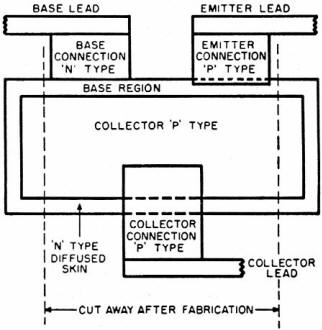
Fig. 4. The diffused base type transistor.
The development of power transistors with acceptable engineering performance
levels at acceptable costs is a most interesting subject. The advantage of transistors
in auto sets is, of course, obvious, for with them an auto set may be made which
will operate directly off the car battery without need for a vibrator-type power
supply which not only takes up space but also, through the years, has been a reliability
problem. Strangely enough, the problem of the power transistor in auto sets has
not been entirely one of power and temperature effects, but rather one of obtaining
adequate gain. A minimum power out-put level of about 3 watts is needed in an auto
set. A single transistor operating class A then must be capable of dissipating about
7 watts allowing for the no-signal conditions and some inefficiency in the output
transformer. With a 14 volt nominal supply the collector current is .5 ampere and
the peak collector current 1 ampere. At these current levels early power transistors
gave such low gains that a medium power unit was needed as a driver.
Design engineers working on hybrid auto receivers with a transistor output stage
and all other stages using tubes operating with 12 volts on their plates soon discovered
that high gain power transistors were also needed here because of the limited power
available from a driver tube operated with 12 volts on its plate.
More gain in the power transistor was mandatory and again transistor development
research solved the problem. The low gain was due primarily to reduced emitter efficiency
at high current densities. The emitter had to be made of even lower resistance material
than indium to correct the situation. Gallium was suitable, but this metal becomes
soft at 100° F. Fortunately it was found that discrete amounts of gallium mixed
with indium would accomplish the trick. As a result there are now power transistors
capable of gains up to 1000 times. Power drive requirements are only about 3.5 milliwatts
for the application discussed, which is easily avail-able from the 12 volt tube,
thus making possible the hybrid auto set.
Cost
Table 1. Manufacturers' Transistor
Sales
Manufacturers' sales of transistors in 1955 were nearly three times as large
as they had been a year earlier.
Factory sales of transistors totaled 3,646,802 units last year compared with
1,317,327 sold in 1954.
The 1955 sales were valued at $12,252,741 at the factory level compared with
a 1954 value of $5,122,266.
The report was estimated by the RETMA Statistical Department on the basis of
information supplied by transistor manufacturers throughout the country. It reflects
total industry activity and includes those transistors which are sold for use in
both entertainment and non-entertainment types of electronic equipment.
But why a hybrid - why not an all-transistor set? The answer, of course, lies
in the fact that one potential advantage of the transistor has not yet been realized;
namely, low cost. The use of a transistor is, therefore, restricted to those applications
where its advantages outweigh its increased cost. In 1953 they replaced tubes in
hearing aids despite a unit price of over $8.00, because of the enormous advantages
they offered in this application. In 1955 their use began to multiply in portable
receivers, despite a price that averaged several times that of a tube, again because
they possessed inherent advantages which were valuable in portable receivers.
However, it is not quite so easy to justify higher costs in auto sets. The consumer
is not concerned with reducing the power requirements or the size of his auto set,
but the auto set designer is concerned with these things -hence the hybrid receiver,
which saves space and battery current without materially running up the price tag.
In the case of television set applications of transistors there is a variation
of the same problem. Here the space saving feature of the transistor is unimportant.
The reduced power consumption would be, except that most of the power consumed goes
into the deflection system, and there is no transistor today that can handle the
job. The situation here seems to be entirely one of cost. When the transistor can
compete directly with the tube costwise, it will appear in television sets.
Reliability
Any discussion of transistors must include some comment on their reliability,
Early transistors were encapsulated in a plastic. In many applications this encapsulation
was adequate, as is well demonstrated by the plastic encapsulated transistors which
are still in use in hearing aids today after over three years of service. However,
plastic units did not stand up well at high temperatures, nor could they survive
under extreme moisture conditions. As a result, extensive effort has been directed
toward the development of hermetically-sealed enclosures. Two problems arose; first,
some units (presumably hermetically sealed) were subject to abrupt failures in varying
percentages because of simple leaks. Second, some that were truly sealed died slowly
as the result of the gradual release of internal co-taminants. Today these problems
seem to be practically eliminated. It is not easy to present definite proof for
the simple reason that chemical reactions play a large part in a transistor's life.
These may begin the day the transistor is encapsulated and, in general, go on whether
the unit is being operated or not. Hence, in a sense, a transistor is always on
life test as compared to a tube where life, in general, only is used up while operating.
Accelerated life tests at high temperatures are, therefore, used to predict transistor
life under more normal conditions. Today such tests predict long and useful transistor
life, although it will take years to accumulate exact information under normal storage
conditions.
Conclusion
The conclusion to be reached on the status of transistors is inescapable. Early
reliability problems are over, costs are dropping, and the .engineering performance
level is rising, Furthermore, the development of the diffused base transistor seems
destined not only to overcome frequency obstacles, but even to point to a high-frequency
performance level superior to tubes. The trend to transistors, already evident in
portable radios, will gradually encompass the auto and home set field and within
a few years begin to establish itself even in some TV set designs.
Posted February 19, 2019
|











 The operator is growing a crystal of silicon
from a crucible containing molten silicon at a temperature of 2650° F. A solid
seed of silicon is placed into the molten pool and the temperature distribution
so arranged by control of the induction heater that freezing begins to take place
onto this seed. The seed is then pulled from the melt, taking with it solid silicon.
The temperature is so controlled that the seed widens into a crystal over one inch
in diameter during growth. Such a crystal can potentially produce over 2000 transistors.
The operator is growing a crystal of silicon
from a crucible containing molten silicon at a temperature of 2650° F. A solid
seed of silicon is placed into the molten pool and the temperature distribution
so arranged by control of the induction heater that freezing begins to take place
onto this seed. The seed is then pulled from the melt, taking with it solid silicon.
The temperature is so controlled that the seed widens into a crystal over one inch
in diameter during growth. Such a crystal can potentially produce over 2000 transistors.




